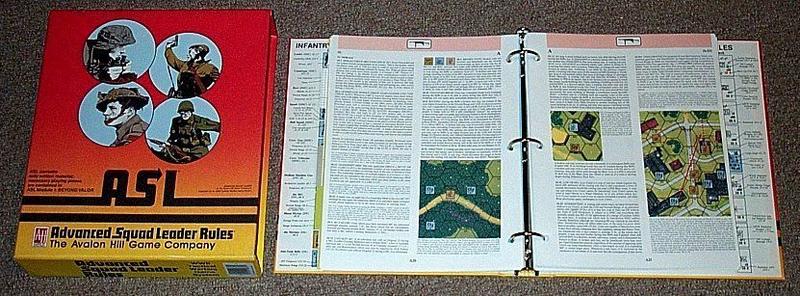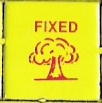Jesper Juul, in Half-Real (MIT 2005) writes about rules: “Game rules are designed to be easy to learn, to work without requiring any ingenuity from the players, but they also provide challenges that require ingenuity to overcome” (55). He continues:
Rules are designed to be above discussion in the sense that a specific rule should be sufficiently clear so that players can agree about how to use it. Rules describe what players can and cannot do, and what should happen in response to player actions. Rules should be implementable without any ingenuity. (55-6)
According to Juul, “Easy to learn but difficult to master” is the paradox at the heart of good game rules. But games with procedurally complex rules are not necessarily flawed or bad games. Advanced Squad Leader (ASL), originally published by the Avalon Hill Game Company, is undoubtedly the most procedurally complex wargame ever designed, and quite likely by extension the most procedurally complex boardgame ever designed. It is not easy to learn, nor master. The game (more properly, game system, you acquire it as a series of modules) focuses on Word War II small unit combat, with counters representing infantry squads and individual leaders, vehicles, and heavy weapons. Here is not the place to go into detail about ASL itself, which in theory allows a player to recreate any small unit action from any theater or phase of the war (see the Wikipedia entry linked above). What I want to focus on is the role of player error in the play of the game. Given the size, scope, and complexity of ASL’s rules—its procedures and their interactions—human error in the application of the rules is inevitable. This situation is anticipated in the rules manual itself (some 200 pages long), with the second rules case of the game stating the following:
A.2 ERRORS: All results stand once play has progressed past the point of commission. In other words, if an error is discovered after play has passed that point, the game cannot be backed up to correct the error, even if such an error is in violation of a rule. For example, assume an attack is resolved without application of a proper DRM [dice roll modifier], and a subsequent attack is resolved, or another unit moved, or play proceeds to another phase before a player remembers he was entitled to a DRM in the previous attack, thus changing the result. His failure to apply that DRM at the time of commission has cost him his right to claim that DRM. Or perhaps a player moves a unit before remembering that he wanted other units to attempt rally in the RPh or fire or entrench in the PFPh. Once the phase for execution of a particular action has passed, the player has lost any claim to that capability.
Thus the game builds the provision for error into its own formal system, so that error is accommodated within the formal structure of game play. The issue with ASL is not that the rules are badly written—the rules manual (pictured below) is for the most part a model of technical clarity—but that the number of rules, and their interactions and permutations is so vast that it is unreasonable to think human players, even experts, will always implement all of them correctly. (Early examples of play published in Avalon Hill’s own house magazine, The General, contained flagrant errors.) On the one hand then, a game of ASL’s formal scope and complexity represents a kind of limit case for Juul’s discussion of rules. (The number of interactions is so complex that ASL players has evolved an axion, COWTRA, “concentrate on what the rules allow.”) Yet ASL also provokes other kinds of questions, including what kind of pleasure one gains from playing such a procedure-heavy game.

An ASL game scenario is a kind of world building. In Juul’s terms, it is both incomplete and (occasionally) incoherent. The game system is capable not only of accommodating movement and firing, but a vast array of other actions. A building struck by an artillery shell may “rubble,” in turn collapsing other buildings around it. Underbrush may be set on fire. Squads may generate heroes, who can become wounded, but nonetheless survive to scrounge an abandoned machine gun which might then malfunction only to be repaired and then lost when the wounded hero is captured (he may then escape). A tank can throw a tread as it crashes through a wall, rotating its turret to fire at a target glimpsed for a moment through a narrow village street. These extraordinary permutations of rules interactions generate what players routinely refer to as “narrative.” (ASL is often described by its fans as representing not real world small unit combat, but World War II as it was refought in Hollywood film.)
Here is some of what ASL has to teach us about complex game rules:
- Games with procedurally complex rules, rules that are not easy to master, can succeed as games;
- Mastery of complex rules builds identity and community: interpretation of ambiguous rules, identification of errata, creating house rules and variants, and helping other players learn the rules are all activities routinely undertaken by ASL players (there is are multiple active player communities online);
- In ASL, the proper application and execution of rules functions as a surrogate for real world military tactics; the designers explicitly tell players that how well they know the rules and can take advantage of them is a reflection of how well they are leading their men (“In essence, the player’s knowledge of the system and methodical applications of its benefits as opportunities present themselves become an added skill factor better representing the abilities of an experienced battlefield commander” [A57]).
- Thus, mastery of a complex rules system is rewarded, not only through more successful game play, but as a explicit surrogate to the game’s fiction;
- Complex rules are conducive to that elusive quality gamers call “narrative”; the perception or experience of narrative often seems to arise from unlikely outcomes or combinations and permutations of rules interactions (such as those described above);
- Finally, rules can safely accommodate and contain the conditions for their own suspension.
I will be writing more about ASL in future posts, including its capacity for “narrative” and possible worlds theory.

